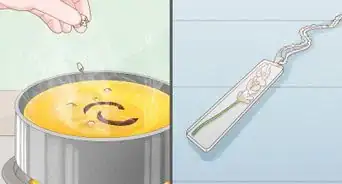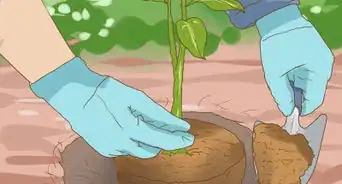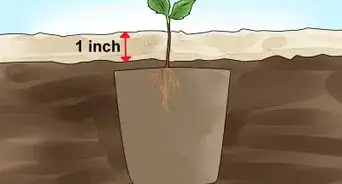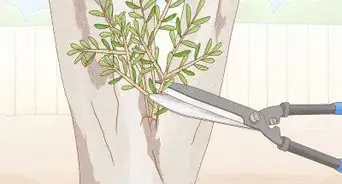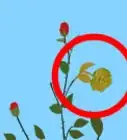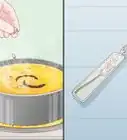This article was co-authored by Andrew Carberry, MPH. Andrew Carberry is a Food Systems Expert and the Senior Program Associate at the Wallace Centere at Winrock International in Little Rock, Arkansas. He has worked in food systems since 2008 and has experience working on farm-to-school projects, food safety programs, and working with local and state coalitions in Arkansas. He is a graduate of the College of William and Mary and holds a Masters degree in public health and nutrition from the University of Tennessee.
wikiHow marks an article as reader-approved once it receives enough positive feedback. This article received 23 testimonials and 92% of readers who voted found it helpful, earning it our reader-approved status.
This article has been viewed 664,809 times.
Plum trees need to be pruned once a year so that they'll retain a healthy shape and produce abundant fruit. The timing is important, since pruning at the wrong time of year can expose the tree to disease. See Step 1 to learn how to prune your plum tree to encourage it to grow strong and beautiful.
Steps
Pruning Young Plum Trees
-
1Prune at the right time. You can prune the tree while it is dormant in winter or in summer. Dormant pruning is pruning the tree during the late winter, when no new growth is happening and the tree doesn't have any leaves. Pruning while the tree is dormant encourages vibrant growth come spring, and it's less likely to cause damage to the tree than summer pruning. Summer pruning can be used to slow the growth of a tree that is getting too big and to thin new growth that is overcrowding.
- Prune as late in the winter as possible before new growth occurs, since heavy freezes after pruning could damage the tree.
- Save some pruning for the summer. Pruning too much in late winter can lead to vegetative overgrowth and reduced fruit production.
-
2Cut the tree to size after planting. It's important to prune a young tree during its first dormant season to encourage good growth and a suitable shape. As soon as possible after planting, cut it down so that it's only about 30 inches (76.2 cm) high.[1] Make the cut just above a bud.
- New growth will occur where you make each cut.
- Use loppers to make clean, sharp cuts. Gouges and jagged edges leave the tree vulnerable to pests and disease.
- After this first pruning, you might wish to paint the tree with white latex paint to keep it from getting sunburned and protect it from pests.
Advertisement -
3Create a scaffold whorl. Choose four branches evenly spaced around the tree to serve as the tree's "scaffold whorl." These branches provide structure and keep the tree's shape balanced. Cut each of the four branches back so that each one has just 1 or 2 buds. Make the cuts just above the buds. Cut the remaining side shoots and branches flush against the trunk.
- For the first two years of the tree's life, prune only during the dormant season and keep the scaffold whorl cut back to 10 inches (25.4 cm).
-
4Create more scaffold whorls in the third year. By year 3, the tree will have produced another set of strong lateral shoots. Create more sets of scaffold whorls that are evenly spaced around the tree. Cut the whorls closer to the top of the tree back to 1 bud, and leave the whorls closer to the bottom 2 buds. The plum tree should take on a vase or Christmas-tree shape, which allows sunlight to filter through and encourage healthy growth.[2]
-
5Keep pruning the trunk. Cut back the trunk by a foot or two each year to control the height of the tree and encourage bushy growth toward the bottom. Prune it so that a bud is left at the tip.
-
6Continue with this pattern until the tree has reached your desired height. For the first 3-5 years of the tree's life, continue creating new scaffold whorls and cutting back the trunk during the tree's dormant period. When you're happy with the tree's height, move on to pruning techniques suitable for older trees.
Maintaining Older Plum Trees
-
1Prune dead and diseased branches. Branches that are dead or diseased should be cut away each year so that the tree can stop wasting energy on them. Use a tree saw or loppers to cut the branches flush with the tree trunk. Be sure to make clean cuts so that the tree isn't vulnerable to further disease.
- If larger branches have developed a collar, cut just outside the collar, a few inches from the trunk.
- Dead and diseased branches can be removed any time of year, since taking them off won't affect the growth of the tree.
-
2Prune branches that don't bear fruit. If you notice a branch or two that don't seem to be producing fruit, you may want to remove them. Make your cut flush with the tree's trunk, rather than just cutting back to a bud, since new growth on the same branch isn't likely to produce different results.
-
3Cut back the suckers. Suckers are new shoots that come up from the root system around the base of the tree. Cut them away so that the tree's energy is directed into the main tree trunk and won't get sapped by the suckers. Cut the suckers all the way to the ground using loppers.[3]
-
4Cut branches that cross over other branches. Each season, the tree is likely to produce new branches that cross over existing branches. It's important to prune the tree carefully so that no crossover branches remain. Crossover branches crowd the tree and prevent sunlight from filtering through the branches. They also inhibit air flow and can leave the tree vulnerable to disease and pests.
-
5Prune in the summer to discourage growth. If your plum tree is getting too big for your yard, you can prune in the summer to slow down its growth. Whereas dormant pruning encourages vibrant spring growth, summer pruning cuts away the tree's energy and limits growth for the season.
- If you prune in the summer, be careful not to cut away too much of the tree.
- Pruning too late in the summer can make the tree vulnerable to cold winter temperatures. In the US, don't prune after July to reduce the risk of frost damage to new growth.
- Beware that summer pruning can cause the tree to put its energy into leaf growth rather than fruit production.
Expert Q&A
Did you know you can get expert answers for this article?
Unlock expert answers by supporting wikiHow
-
QuestionAfter pruning, should I use pruning sealer?
 Andrew Carberry, MPHAndrew Carberry is a Food Systems Expert and the Senior Program Associate at the Wallace Centere at Winrock International in Little Rock, Arkansas. He has worked in food systems since 2008 and has experience working on farm-to-school projects, food safety programs, and working with local and state coalitions in Arkansas. He is a graduate of the College of William and Mary and holds a Masters degree in public health and nutrition from the University of Tennessee.
Andrew Carberry, MPHAndrew Carberry is a Food Systems Expert and the Senior Program Associate at the Wallace Centere at Winrock International in Little Rock, Arkansas. He has worked in food systems since 2008 and has experience working on farm-to-school projects, food safety programs, and working with local and state coalitions in Arkansas. He is a graduate of the College of William and Mary and holds a Masters degree in public health and nutrition from the University of Tennessee.
Food Systems Expert
-
QuestionWhen do I prune a plum tree that is in a pot?
 Andrew Carberry, MPHAndrew Carberry is a Food Systems Expert and the Senior Program Associate at the Wallace Centere at Winrock International in Little Rock, Arkansas. He has worked in food systems since 2008 and has experience working on farm-to-school projects, food safety programs, and working with local and state coalitions in Arkansas. He is a graduate of the College of William and Mary and holds a Masters degree in public health and nutrition from the University of Tennessee.
Andrew Carberry, MPHAndrew Carberry is a Food Systems Expert and the Senior Program Associate at the Wallace Centere at Winrock International in Little Rock, Arkansas. He has worked in food systems since 2008 and has experience working on farm-to-school projects, food safety programs, and working with local and state coalitions in Arkansas. He is a graduate of the College of William and Mary and holds a Masters degree in public health and nutrition from the University of Tennessee.
Food Systems Expert
-
QuestionWhat is the optimum height for a plum tree?
 Community AnswerNo taller than about 25 ft, but it depends on how tall your ladder is, as you will need to be able to reach the top to harvest the fruit. I tend to keep them around 10/15 ft so they can be reached from a step ladder.
Community AnswerNo taller than about 25 ft, but it depends on how tall your ladder is, as you will need to be able to reach the top to harvest the fruit. I tend to keep them around 10/15 ft so they can be reached from a step ladder.
Warnings
- Dispose of all cuttings to avoid transfer of disease.⧼thumbs_response⧽
- Avoid mid-summer pruning or you might find the plum tree puts all its energy into amazing foliage growth rather than to fruiting.⧼thumbs_response⧽
Things You'll Need
- Pruning saw
- Loppers
- Tree sealant
- Garden gloves
- Suitable disposal methods for cut pieces
References
About This Article
To prune a plum tree, wait until the tree is dormant in the winter if you want to encourage more growth in the spring, or prune it during the summer if you want to slow its growth. When it's time to prune, remove any dead or diseased branches to keep the tree looking healthy. Also, prune off any branches that aren't producing fruit. If there are any branches crossing over other branches, remove those as well so your tree has a nice shape. For tips on pruning a young plum tree, keep reading!

